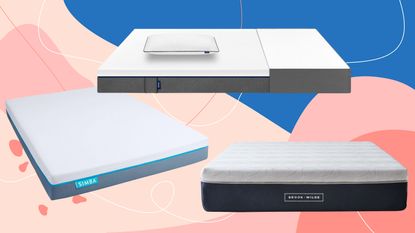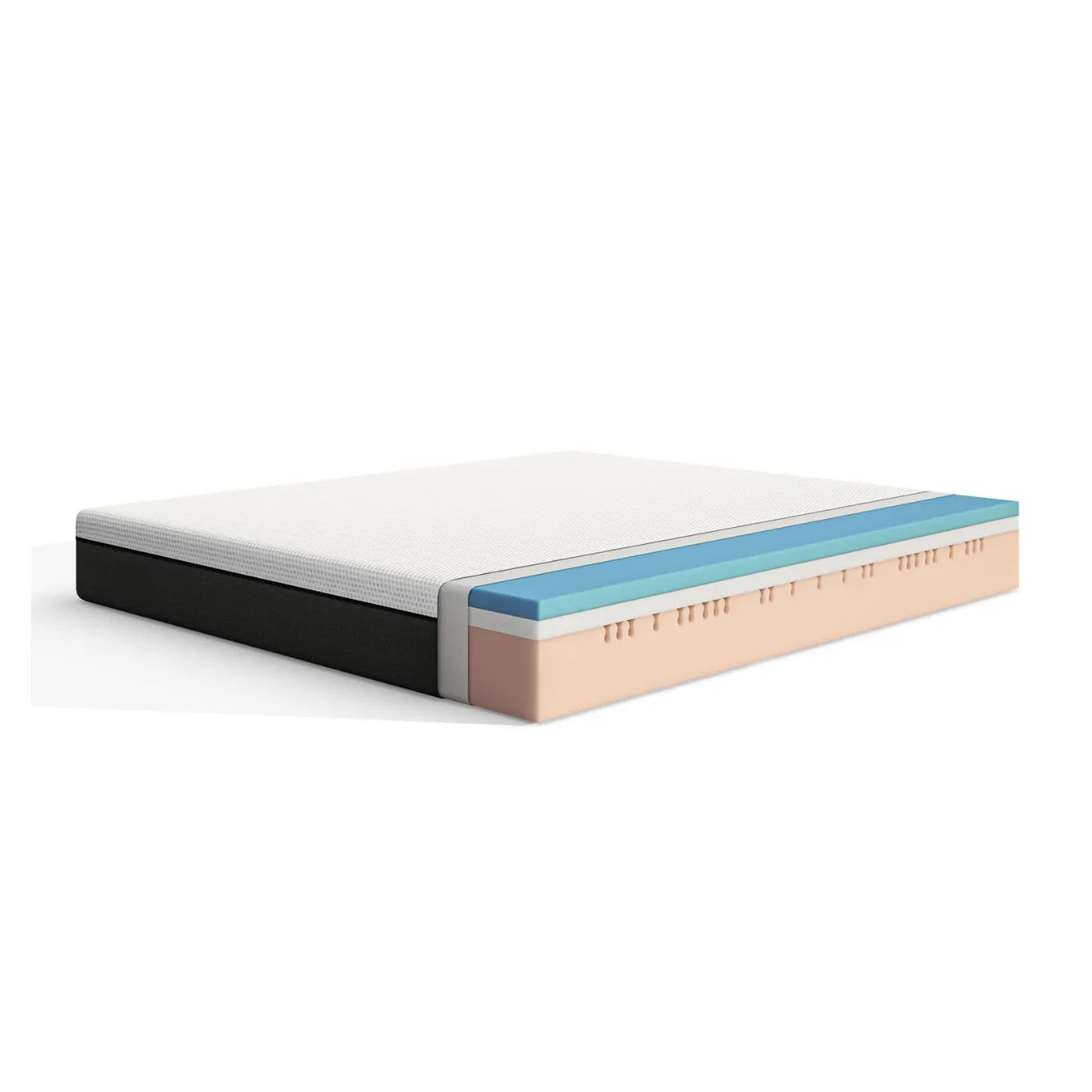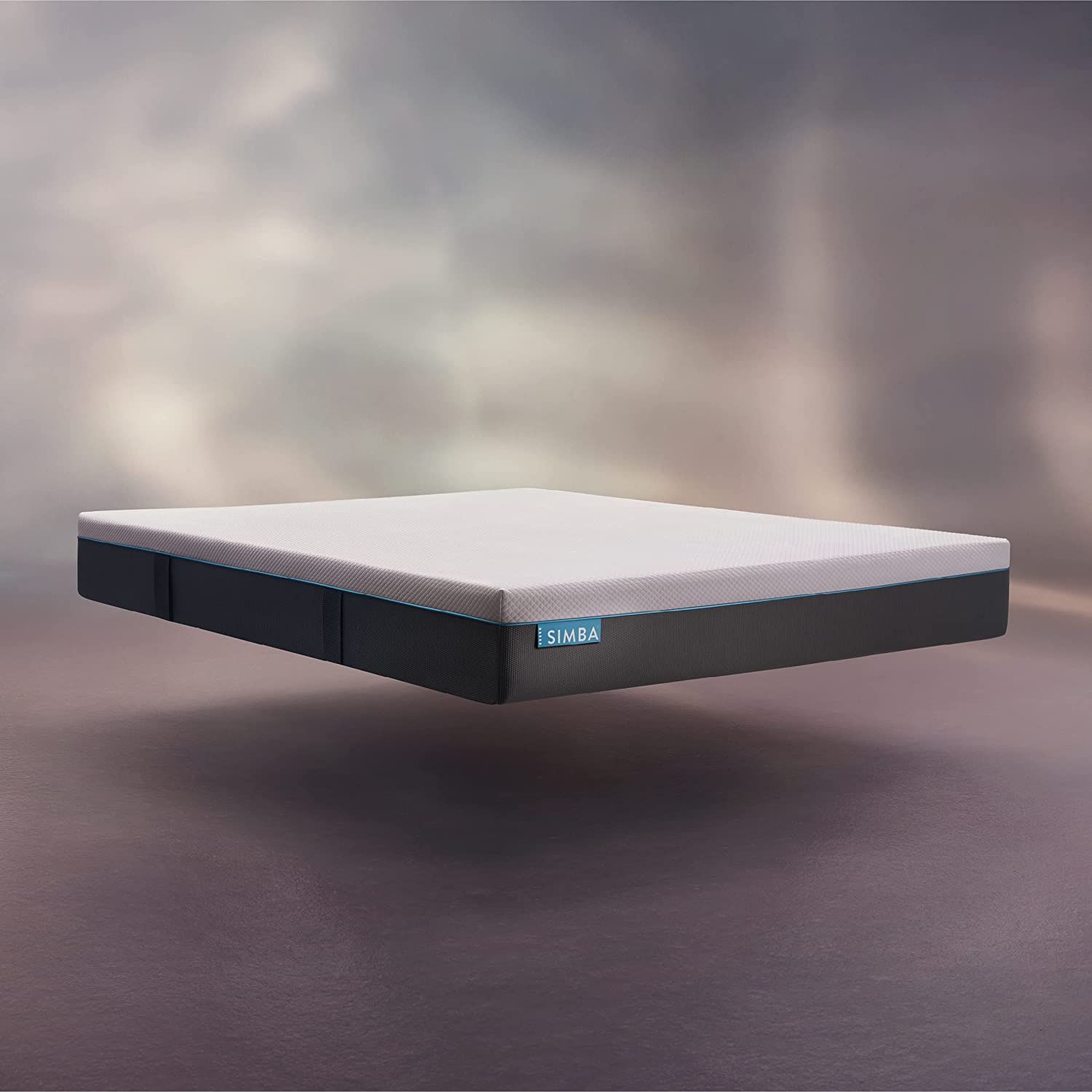Best mattress 2023 – tried and tested memory foam, pocket spring, and hybrid mattresses
We've reviewed the best mattresses from the biggest brand names – including Emma, Simba, and Silentnight – here's our verdict on which to shop
- (opens in new tab)
- (opens in new tab)
- (opens in new tab)
- Sign up to our newsletter

Finding the best mattress for your most restful night’s sleep can be a highly subjective decision. Individual preferences like our sleeping style – that’s whether we’re a front, side, or back sleeper – our weight, body temperature, and any pre-existing aches and pains, plus whether we sleep alone or with a partner, can all affect which mattress is best for us.
And, of course, there’s also budget to consider. Whether you’re looking for a cheaper mattress that’s under the £500 mark or a luxury mattress at over £2000 – there’s no denying that a new mattress is a significant investment, so it’s a decision we all want to get right.
That’s where the Ideal Home guide to the best mattresses is here to help. We aim to cut through the manufacturers marketing spiel and help you to narrow down which mattress is really right for you, weighing up the pros and cons of memory foam, hybrid, and pocket sprung mattresses, plus digging into the detail to see what you’re really getting for your money.
Our team has tried, tested, and rated bestselling mattresses from the biggest brand names in the sleep field – including Emma, Simba, and Silentnight – putting each mattress through its paces to compare comfort, motion transfer, edge support, and temperature regulation, as well as ease of delivery and care. You’ll find in-depth mattress-buying advice at the bottom of this page, along with our top recommendations (gleaned from hours of comfortable snoozing) just below.
And, if you want to ensure you have all of the ingredients for a good night's sleep, then don't forget to read our guide to the best pillows as well!
Best mattresses – tried and tested
Why you can trust Ideal Home Our expert reviewers spend hours testing and comparing products and services so you can choose the best for you. Find out more about how we test.


Specifications
Reasons to buy
Reasons to avoid
The Emma Original is an affordable foam-only mattress constructed from a base layer of high-density foam with top layers of memory foam designed to 'hug' the body and cushion pressure points.
Our reviewers have universally found this mattress extremely comfortable on initial testing, agreeing that on a scale of firmness from 1 to 10, they rate the Original at a 5 (medium) which makes it a soft and cushioning surface to sleep on, even going so far as to call it 'dreamy' and 'unbelievably comfy'. The memory foam surface also makes for very little motion transfer thanks to its movement-dampening effect – a big bonus if you sleep with a fidgety partner.
The boxed delivery packaging is super useful for homes with awkward access, there's a generous 200-night sleep trial to allow you to fully test it before committing, and the brand regularly slashes prices meaning you can often pick up the Original at 50% off.
The compromise for the affordable price point is the lack of springs. That means you don't get the bounce that you'd get from a hybrid or pocket-spring mattress, and, without that additional spring support, over time some reviewers have noted indentations in the foam if the mattress isn't regularly rotated. Those of us on the heavier side of the weight spectrum, or who are front sleepers, may also be likely to find the all-foam construction too soft – a pocket-spring or hybrid mattress will offer more support. And, several reviewers have noted some overheating due to the memory foam's lack of breathability, so it may not be the best buy for a hot sleeper.
However, if you're after a soft, cushioning, and affordable mattress, that offers a generous sleep trial and hassle-free delivery, then we think you'll find the Emma Original is a bestseller for good reason.
Read our full Emma Original mattress review for more detail.


Specifications
Reasons to buy
Reasons to avoid
If you're looking for a mattress with a little more bounce but that still has plenty of cushioning, then you'll want to opt for a hybrid mattress. A hybrid mattress generally combines the support of pocket springs with the comfort of a memory foam upper. You'll usually pay more for the addition of those springs, but it can mean your mattress has more longevity and is a particularly good option if you're a heavier sleeper who needs a firmer base layer for support.
The Simba Hybrid mattress is a popular option that combines 2500 springs with a top layer of the brand's Simbatex® foam – the brand describes this as ‘open cell’ memory foam, which allows thirty times the airflow of memory foam to prevent overheating during the night.
Whilst some of our heavier reviewers found it on the softer side, most of our testers described this as the Goldilocks of mattresses – i.e. not too soft or too firm. They also found it particularly comfortable when side-sleeping, with the soft memory foam surface providing sink-in support for the shoulders. Back sleepers were also impressed, although the memory foam top was less suitable for front sleepers.
Like Emma, Simba offers mattress-in-box delivery, which makes for easy transportation to the room of your choice, and offers a generous 200-night sleep trial if you buy direct from the brand. If you time your purchase to coincide with one of the Simba's regular up to 50% off sales you can also get this great all-rounder mattress at a great price.
Read our full Simba Hybrid mattress review for more detail.


Specifications
Reasons to buy
Reasons to avoid
The Brook + Wilde Ultima mattress is a true all-rounder; comfortable, supportive, and cool to sleep on, our reviewers couldn’t fault it. However, it is an investment, so what makes it worth the extra spend?
Firstly, with this mattress, you can choose from a range of firmness levels, so there's an option for you whatever your sleep style or tension preference. That said, our reviewer tested the Ultima in a medium firmness level and thought this was the perfect tension for both side, back, and front sleepers.
Secondly, this hybrid mattress offers a lot of bang for your buck, with a construction that includes ten layers of comfort and support. There are two memory foam layers, crafted from 'open cell' foam that allows 4 times the airflow of regular memory foam. Plus a 'twin blanket of 2000 nano-springs, ergonomically designed to evenly distribute your weight', and another layer of 4000 taller pocket springs, that the brand states 'provides the perfect level of push-back and bounce'.
Our reviewer certainly agreed, finding after a few nights on the Ultima her lower back pain was a thing of the past, and also praising the lack of motion transfer when her partner tossed and turned nearby. The removable and machine-washable thermic cover also kept our testers cool as they slept through two heatwaves.
All those layers do mean this mattress is heavy, and at 30cm deep it's well worth checking the height of your bed frame to make sure the sleep surface won't end up too high. That said, our testers found it hard to find other faults – other than the price. However, Brook + Wilde does run regular offers of up to 60% off on occasion, so time your purchase right and you could be able to snap up this luxury mattress for less.
Read our full Brook + Wilde Ultima mattress review for more detail.
Brook + Wilde Ultima mattress | was from £2199 now from £879.60 at Brook + Wilde (opens in new tab)
This luxury mattress is a true all-rounder; we couldn’t fault it when we put it to the test. However, from £2199 for a double, it's a real investment. That's why 60% off with code SAVE60 is a very welcome discount.


Specifications
Reasons to buy
Reasons to avoid
The Emma Premium mattress, as the name might suggest, is the Emma brand's top-of-the-range mattress, which in real terms means it's a hybrid design that combines a memory foam upper with pocket-spring support, unlike the entry-level Emma Original mattress that is foam only.
Our reviewers instantly noticed the difference between the softer Original mattress and Medium-Firm Premium mattress, noting that after a week or so to adjust to the firmer sleep surface the Premium felt both 'supportive and cushioning'. Heavier weight sleepers will definitely appreciate the extra support the springs add, and the hybrid construction is also likely to give the mattress more longevity.
The hybrid Emma Premium mattress is often looked at in comparison to the Simba Hybrid mattress, and having put both to the test we have to say they're pretty much neck and neck in design. Some of our testers found the Emma Premium to be the slightly warmer of the two with a little less breathability than the Simba Hybrid, and some found the Simba Hybrid slightly more comfortable which is why Simba's offering just pips the Emma Premium to the post in this round-up.
That said, we think the largest determining factor if choosing between the two is likely to be price. Both brands offer regular discounts of up to 50% off, so depending when you shop, your best bet is to opt for the one with the heftiest discount.
Read our full Emma Premium mattress review for more detail.


Specifications
Reasons to buy
Reasons to avoid
If you're not keen on memory foam, and/or you want to invest in a mattress that's making efforts to curb its environmental impact, then REM-Fit's new Eco Premium Hybrid Mattress could be for you.
The mattress is constructed using 3000 pocket springs – made up of 2000 mini pocket springs and 1000 14.5cm tall pocket springs – topped with what the brand has dubbed 'EcoFoam'. This 'EcoFoam' layer provides an alternative sleep surface to the usual memory foam mattress upper found in hybrid mattresses and is made from recycled fibres. This foam is also utilised to create side walls around the mattress; the aim being to allow you to sit or sleep close to the edge of the mattress without 'roll off'.
The mattress is then encapsulated in a Seaqual® fabric cover. The Seaquall Initiative (opens in new tab) works with NGOs, fishermen, communities, authorities, and industry to help clean our oceans of marine litter, repurposing plastic pollutants into yarn that can be used to create a whole host of products. As consumer purchasing power is one of the most powerful tools for change, by investing in this mattress, you're funding further development into more sustainable manufacturing practices – and that gets a big thumbs up from us.
Our side and back sleeping reviewer loved the firm yet cushioned sleep surface, although the foam top layer did make this option a little soft for our front sleepers. Our testers also loved the mattress' more eco-friendly materials, which they noted in no way comprised the comfort levels.
Read our full REM-Fit Eco Hybrid Mattress review for more detail.


6. Nectar Memory Foam mattress
Our expert review:
Specifications
Reasons to buy
Reasons to avoid
Similar to the Emma Original mattress, the popular Nectar Memory Foam mattress is an all-foam affair with no springs in sight.
Just like the Emma Original, that makes for a cushioned sleep surface that's a good option for side sleepers, with very little motion transfer thanks to the movement-dampening effect of the memory foam top layer. Nectar's mattress-in-a-box delivery also makes for easier delivery to homes and rooms with awkward access. However, that pure foam construction means the mattress may be a little too soft for those of us on the heavier side, or for front sleepers, who will both find a pocket-spring or hybrid mattress to offer better support.
So how to choose between the Emma Original and the Nectar Memory Foam mattress? Well, we have a few niggles with the Nectar option – largely the lack of side handles for rotation, the fact the cover isn't removable like the machine-washable Emma Original cover, and the 'new mattress' off-gassing smell that our reviewer found took a little longer to dissipate compared to other mattresses.
That said, Nectar offers one of the longest sleep trials in the business if you buy direct – that's currently a whopping 365 nights to test out the Nectar Memory Foam mattress and ensure it's the right option for you (just make sure to double-check the Terms & Conditions before you buy). Emma's sleep trial is also lengthy at 200 nights, but we all know time can fly, so a year's worth of snooze-testing is a big selling point.
Price-wise, the Nectar Memory Foam mattress is generally the more expensive option at full RRP, but regular discounts can mean that prices are slashed beyond that of Emma, so in terms of affordability it's all about when you shop.


Specifications
Reasons to buy
Reasons to avoid
The Eve Premium Hybrid mattress is another popular hybrid mattress-in-a-box offering, that gives the Simba Hybrid mattress and Emma Premium mattress a run for their money.
As an overview, the design is very similar to the Simba and Emma hybrid offerings, with a top layer of memory foam to add cushioning and pocket springs to offer support. We found that, like the Emma Premium, it sleeps a little firmer than the Simba Hybrid mattress – if you're of a slight build that might mean you find it too firm, but if you're on the heavier side then you might appreciate that tad more resistance. This mattress also offers a 28cm depth compared to the Simba Hybrid and Emma Premium's 25cm depth, although we didn't find that made too much difference in practical terms.
The Simba Hybrid offers up to 2500 mini coil springs, whereas the Eve Premium contains up to 1400 full-size springs (and Emma keeps shtum on how many the Premium contains), but we found both to offer good support and do a great job of motion isolation if you have a fidgety partner. The Eve Premium was also a popular choice with our hot sleepers, most finding it on a par with the Simba Hybrid at offering a more breathable memory-foam sleep surface than the Emma Premium.
If we're being nit-picky then we missed the side handles that make rotating the Simba and Emma mattress a breeze, and – although we love Eve's eyecatching bright yellow branding – the yellow mattress piping remains visible even with a mattress protector and sheet in place. However, Eve's current 365-night sleep trial blows Emma and Simba's 200-night trials out of the water. Overall, the best choice between these hybrids is likely to come down to discounts on offer at the time of purchase, and Eve generally offers some hefty reductions.
Read our full Eve Premium Hybrid mattress review for more detail.


Specifications
Reasons to buy
Reasons to avoid
Memory foam mattresses have become hugely popular in recent years, mainly due to the way that memory foam slowly contours to the body as a sleeper's body heat warms it up, offering a cocooning sleep surface moulded to your exact dimensions.
A latex-topped mattress offers similar cushioning properties but can be quicker to respond as it doesn't rely on body heat to activate its elasticity. It also provides a more general contour that some prefer to the enveloping 'hug' of memory foam.
Silentnight's Lift Replenish Hybrid 2000 Mattress is made up of 2000 pocket springs topped with a 2cm latex layer and wrapped in a fabric cover that the brand calls an “Intense™ sleep surface”. This means that the fabric has carbon woven into it in order to reduce static electricity which builds up in our bodies naturally throughout the day. The brand says that this static can limit the production of the sleep hormone, melatonin, which helps people get better sleep. So in theory, less static equals a deeper sleep.
The mattress is available in two firmness options – medium-soft and medium-firm – and whilst our reviewer found the medium-firm was definitely on the firmer side of the equation (and that that latex upper made for an extremely heavy mattress to move), she testified to its overall comfort and the good night's sleep it offered.
Read our full Silentnight Lift Replenish Hybrid Mattress review for more detail.


Specifications
Reasons to buy
Reasons to avoid
Trying to find an eco-friendly mattress can be a tall order, which is why we were keen to test out Woolroom's Hebridean mattress.
This pocket-spring mattress combines 1000 pocket springs and 2000 micro coil springs with an all-natural fill made from a mix of wool, cashmere, silk, and cotton – a combination that's gentler on the environment in terms of manufacture and biodegradability than a synthetic mattress.
As the name suggests, Woolroom is big on wool, and if you spend a little time digging into the detail, it's easy to see why. The perfect bedding material – that fell out of favour when cheaper foams and polyesters entered the market – wool is insulating, breathable, temperature regulating, hypoallergenic, durable, and a sustainable and renewable resource.
Importantly for mattress production, wool is also a natural fire retardant, which means none of Woolroom's mattresses are coated in the chemical fire retardants required for synthetic mattresses.
Although it's an investment at just over £1000 for a double, that's actually a fairly reasonable price for a traditionally made, hand-tufted mattress that's filled with natural fibres. We found its firmer sleep surface a good fit for heavier-weight and front sleepers, plus wool's temperature-regulating attributes made it a great option for hot sleepers. And for those sensitive to the chemical off-gassing of memory foam, latex, or synthetic mattresses, this all-natural mattress could prove a great solution.
Read our full Woolroom Hebridean 3000 mattress review for more detail.
What is the best mattress?
Whilst choosing the best mattress for you is very much about personal preference, there are some key considerations that are well worth bearing in mind to help you find the best mattress for your sleep preferences.
First up, it's helpful to understand some basic mattress terminology before starting your mattress search.
In an effort to stand out from the crowd, mattress manufacturers tend to employ an often bewildering array of fancy terms aimed at convincing us that their particular mattress is going to transform our sleep experience and turn us into our best well-rested selves.
However, starting with the basics, there are three main types of mattress construction it's helpful to be familiar with; pocket-spring, hybrid, and foam. We sum up the main differences between each mattress type below.

What is a pocket-spring mattress?
A pocket-spring mattress features a layer of coiled springs topped with either foam or natural-fill padding.
Pocket-spring mattresses tend to be the firmest mattresses and the most bouncy. This can make them the easiest to change position on and make getting out of bed easier as your body doesn't sink into the surface as it will with a memory foam or hybrid mattress. That firmer surface is also great for front sleepers.
But, those same qualities can mean that you'll encounter increased motion transfer on a pocket-spring mattress as without the dampening effect of a memory foam or latex top layer a partner's movement is more noticeable, so you might find there's more sleep disturbance if your sleep partner fidgets.
If you're a side sleeper then you may also find the sleep surface a little too firm, as it doesn't offer the sink-in factor to cushion hips and shoulders that a pillow-top, hybrid, or memory foam mattress does.
What is a hybrid mattress?
Increasingly popular, a hybrid mattress is the mid-ground between a pocket-spring mattress and a foam mattress. These mattresses combine a pocket-sprung layer with a memory foam or latex upper.
This combination works well for a wide range of sleepers – especially side sleepers – as the pocket springs offer good support, whilst the memory foam or latex upper adds some softness to cushion joints.
That cushioned upper layer is also great news for motion isolation, with the sink-in top layer dampening the movements of a fidgety partner.
The downsides are that there's not as much bounce compared to a pocket-spring mattress, and not everyone enjoys the sensation of memory foam moulding to their contours as they sleep, with hot sleepers often finding this leads to overheating.
What is a foam mattress?
A foam mattress contains no pocket springs. It will either feature a denser foam base layer topped by a more cushioned foam upper, or it may have the addition of a memory foam top layer.
Generally, a foam mattress will be the cheapest mattress you can buy. They tend to be best for lighter-weight sleepers due to the lack of spring support, and they'll suit a side sleeper best as front and back sleepers may find the foam sinks too much for comfort.
If you struggle with mobility you might also find an all foam mattress difficult to get out of and turn over in as there's little to no bounce without those springs. Edge support can also be poor, so sitting on the edge of the mattress you'll sink rather than having a firmer surface to stand up from. That sink-in factor is good news for motion isolation though, with the all foam construction dampening the movements of any sleep partners for a less disturbed sleep.
In general, a foam mattress is unlikely to last quite as long as a mattress that has pocket-spring support, and you're more likely to find the sleep surface forms dips over long-term use.
Do you sleep on your side, back, or front?
Your favourite sleeping position can be a big determining factor in which type of mattress you'll find the most comfortable, so it's important to consider whether you're predominantly a side, back, or front sleeper before you start mattress shopping.
This is because the spine needs to be supported differently for optimum alignment in each of the respective sleep positions, and that's where mattress firmness comes into play.
As a general rule, mattresses tend to range from soft-medium, medium, and medium-firm, to firm, and extra firm. However, there are no industry-wide standards of mattress firmness, so one manufacturer's medium rating can sometimes be another brand's firm. That's why we always try to include our tester's firmness findings in all of our reviews.
Your mattress firmness preferences are always a personal decision – there are no right or wrong answers – but below are the generally agreed-upon recommendations for each type of sleeper.

What's the best mattress for side sleepers?
Sleeping on your side allows your spine to relax and therefore takes the pressure off of the back. This makes it one of the healthiest ways to sleep. Side sleepers will generally prefer the cushioning of a medium-soft or medium-firm mattress that allows the shoulder and hips to sink in a little whilst supporting the waist so that the spine can rest in its most natural position.
A hybrid mattress that mixes a pocket-spring base layer with a memory foam or latex top layer can be a popular choice for this style of sleeping due to the cushioning effect that enables the mattress sleep surface to mould to the curves of the body and support natural spine alignment.
If you're solely a side sleeper, then you could also opt for a more affordable all-foam mattress. This will save you some cash compared to a hybrid mattress, and you likely won't miss the additional spring support as much as a front or back sleeper.
Best for side sleepers: medium-soft to medium-firm
What's the best mattress for back sleepers?
If you're a back sleeper then a medium-firm mattress may well be the best option for you, as it will offer support to the hips and upper back whilst adding a little cushioning to support the lower back too.
Memory foam can also be a good option for this sleep position, although you'll likely want a slightly firmer surface than a side sleeper. You'll probably also prefer a hybrid or pocket-spring mattress for the additional support they offer as opposed to an all-foam mattress.
Best for back sleepers: medium-firm to firm
What's the best mattress for front sleepers?
Generally, this is the sleep style least recommended by osteopaths due to the pressure it can put on the neck, however, front sleeping is still the position of choice for a minority of us. If this is you then your mattress choice could help eliminate some of the pressure put on your spine when sleeping in this position.
A firm mattress is the best option here as it will keep the hips lifted rather than allowing them to sink, therefore reducing the unnatural curvature of the spine.
You're likely to sleep best on a pocket-spring mattress, as a hybrid mattress topped with memory foam, or an all-foam mattress, are both likely to be too soft for your needs.
Best for front sleepers: firm

Do you sleep alone or with a partner?
Whilst this might seem like a bit of a personal question, sharing our bed can have a big impact on potential sleep disturbance, so it's an important factor to consider when choosing a mattress.
Unfortunately, your mattress choice might not be able to eliminate all of your partner's annoying sleep habits, but if one of you tends to toss and turn in the night or fidget before finding the most comfortable sleep position, or you go to bed and get up at different times, then opting for a mattress with good motion isolation can prevent a lot of night-time disturbance.
There are two main factors that help to add good motion isolation to a mattress. One is the addition of mini coil springs to a pocket spring or hybrid mattress. These smaller springs can help to absorb and reduce the amount of bounce in the mattress, and therefore reduce vibrations from one side of the mattress to the other – so far less risk of your partner bouncing you out of bed as they exuberantly get in! The other is the addition of a cushioned top layer – like memory foam or latex – which will absorb and have a dampening effect on each partner's movements.
Both are well worth considering if a fidgety sleep buddy is waking you up at night!
Do you tend to overheat in the night?
If you regularly wake up too hot at the night, then it could well be your mattress to blame.
Alongside synthetic bedding, the biggest culprit for night-time sweats is a synthetic mattress. Our bodies naturally give off heat and moisture during the night, and with a synthetic mattress, this heat and humidity can be reflected back toward the sleeper.
Whether foam or memory foam, a synthetic mattress is made of materials that are a variation on polyester or polyurethane – both of them forms of plastic derived from petroleum – and, if you think of their essence as being similar to a plastic bag, it's easy to see why a synthetic mattress can lack breathability and get hot and sweaty pretty quickly!
As such, most synthetic mattress manufacturers spend a lot of time and money trying to come up with innovative ways to combat the lack of breathability of these man-made synthetic fibres.
A mattress filled with natural materials will generally do the best job of offering breathability and providing the coolest sleep. In our tests, we've found wool-fill mattresses in particular are the hot sleeper's best friend.
Wool does a great job at regulating temperature throughout the night, helping those prone to overheating or night sweats to maintain a comfortable, steady temperature, and therefore secure a deeper night's sleep. No wonder, seeing as a sheep's temperature-regulating fleece keeps it warm in the winter and cool in the summer!
Wool is also naturally absorbent, wicking moisture away from the body and releasing it into the air, therefore creating a 'breathable' mattress that's ideal for hot sleepers.
An entry-level natural-fill or wool-filled mattress will generally be more of an investment than an entry-level synthetic mattress, but if nighttime overheating is affecting your sleep quality then it can be an investment in well-being well worth making.
If overheating is a concern but you want the affordability of a synthetic mattress, then look out for terms like 'air-flow' and 'cooling' which generally demonstrate attempts have been made to allow the dissipation of heat away from the body. A wool mattress protector or mattress topper can also do a great job of helping to combat the overheating associated with a synthetic mattress.
Is delivery access an issue?
You've chosen your perfect mattress, but now you need to get it into your house, and more importantly your bedroom!
It probably goes without saying that most mattresses are both heavy and bulky. Generally speaking, the more expensive your mattress is then the heavier it will be as there are likely to be more layers and springs going on inside it. That said, a memory foam top layer will add significant weight to even a budget mattress.
Most mattress retailers and manufacturers will offer mattress delivery to the room of your choice, although in some cases you may have to pay a little extra for this service. If you're not able to heft a mattress around by yourself, then make sure to check the delivery details before you buy.
It's also your responsibility to ensure there's sufficient access for a mattress delivery. Many brands, like Emma and Simba, offer 'mattress-in-a-box' delivery, where the mattress comes rolled up (and boxed) to make getting it around awkward staircases and through doorways easier. However, thicker mattresses are likely to be delivered flat, and have differing flexibility, so it's always worth checking access measurements with the customer services team to make sure there are no nasty surprises on delivery day.
You may also want to consider how you'll get rid of your old mattress – which can be easier said than done. Some mattress retailers and manufacturers will offer to remove your old mattress when they deliver your new one (which can be a risk as if you need to return the new one, you'll have nothing to sleep on!). However, as most councils charge for mattress collection, it's worth checking if this is included in your delivery as a way of saving some extra money.

Do you want to take advantage of a sleep trial?
A wide range of mattress manufacturers now offer sleep trials to allow you to test out a mattress in the comfort of your own home, night after night, before committing.
This can be a great way of taking some of the stress out of this major investment purchase, especially as experts tend to say it can take up to three months to get used to sleeping on a new mattress.
You'll usually have to pay for the mattress upfront, and there will generally be terms and conditions to abide by to qualify for a return and refund so always check the small print, but a sleep trial can be a great way to find out of a mattress is the right fit for you.
Generally speaking you'll need to buy from the mattress manufacturer direct to take advantage of a sleep trial, and trial periods can differ considerably in length, with Emma and Simba both currently offering a 200 night sleep trial, and Nectar offering a whopping 365 nights.
How to look after your mattress
A new mattress is an investment, so once you've chosen your best buy, you'll want to care for it properly to ensure its longevity.
First up, you want to prevent any dirt and spills. Some mattresses come with removable covers that can be washed, but if not it's easy to add your own. Read our guide to the best mattress protectors to find the right option for you.
You'll also want to follow the mattress manufacturer's recommendations for rotation or turning to make sure your mattress wears evenly without you creating any dips from laying in the same spot every night.
How often should you replace your mattress?
Experts say your should replace your mattress roughly every seven years. Of course this isn't an exact science – the type of material you choose and how you sleep will impact on this. A restless sleeper might give their mattress a bit more to contend with than your deep sleeper starfish. Of course, a poor quality mattress might not reach this six to eight year bracket and that is why we recommend buying the best you can afford at the time to ensure longevity. Buy cheap, buy twice after all.
How we test mattresses
We only recommend mattresses that we've tested in person. Each mattress has been sent to the home of the reviewer and slept on for a minimum of a month, in many cases far longer, which gives our reviewers the opportunity to adjust to a new sleep surface and assess a mattress's performance over time. And, as the British weather is so changeable, a longer testing window is a great chance for us to see how it measures up in the temperature regulation department.
We aim to test the bestselling mattresses from all of the leading brand names, whilst also covering a good range of material and construction options, and a wide range of price points. Click here to find out more about how we review products at Ideal Home.
-
 Ultimate kitchen spring cleaning checklist – the only kitchen cleaning list you’ll need
Ultimate kitchen spring cleaning checklist – the only kitchen cleaning list you’ll needCheck these chores off to keep your kitchen in tip top condition
By Tara King
-
 How to get rid of moss in a lawn – 5 steps to healthy grass
How to get rid of moss in a lawn – 5 steps to healthy grassFollow these tried and tested expert methods to rid your lawn of moss
By Rachel Crow
-
 These old drawers got a surprisingly new look with Farrow & Ball's beverly paint
These old drawers got a surprisingly new look with Farrow & Ball's beverly paintVinterior and Farrow and Ball have teamed up to show us how to give secondhand furniture a luxury spin
By Laurie Davidson



